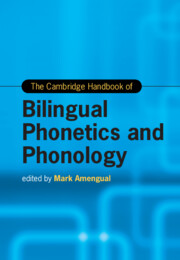Book contents
- The Cambridge Handbook of Bilingual Phonetics and Phonology
- Cambridge Handbooks in Language and Linguistics
- The Cambridge Handbook of Bilingual Phonetics and Phonology
- Copyright page
- Dedication
- Contents
- Figures
- Tables
- Contributors
- Acknowledgments
- Introduction Bilingual Phonetics and Phonology
- Part I Approaches to Bilingual Phonetics and Phonology
- Part II Theoretical Models of Bilingual Phonetics and Phonology
- Part III The Phonetics and Phonology of the Bilingual Child
- Part IV The Phonetics and Phonology of the Bilingual Adult
- Part V The Diversity of Bilingual Speakers
- Part VI Variables and Outcomes of Bilingual Speech
- 29 Language Dominance Effects in the Phonetics and Phonology of Bilinguals
- 30 Code-Switching and Language Mode Effects in the Phonetics and Phonology of Bilinguals
- 31 Orthographic Effects in the Phonetics and Phonology of Second Language Learners and Users
- 32 Phonetic and Phonological L1 Attrition and Drift in Bilingual Speech
- 33 Bilingual Speech Intelligibility
- 34 Using a Characteristic Speech Production (CSP) Procedure to Elicit Monolingual and Bilingual Speech
- 35 Bridging the Gap between Bilingual Phonetic Research and Pronunciation Teaching
- Index
- References
35 - Bridging the Gap between Bilingual Phonetic Research and Pronunciation Teaching
from Part VI - Variables and Outcomes of Bilingual Speech
Published online by Cambridge University Press: 14 November 2024
- The Cambridge Handbook of Bilingual Phonetics and Phonology
- Cambridge Handbooks in Language and Linguistics
- The Cambridge Handbook of Bilingual Phonetics and Phonology
- Copyright page
- Dedication
- Contents
- Figures
- Tables
- Contributors
- Acknowledgments
- Introduction Bilingual Phonetics and Phonology
- Part I Approaches to Bilingual Phonetics and Phonology
- Part II Theoretical Models of Bilingual Phonetics and Phonology
- Part III The Phonetics and Phonology of the Bilingual Child
- Part IV The Phonetics and Phonology of the Bilingual Adult
- Part V The Diversity of Bilingual Speakers
- Part VI Variables and Outcomes of Bilingual Speech
- 29 Language Dominance Effects in the Phonetics and Phonology of Bilinguals
- 30 Code-Switching and Language Mode Effects in the Phonetics and Phonology of Bilinguals
- 31 Orthographic Effects in the Phonetics and Phonology of Second Language Learners and Users
- 32 Phonetic and Phonological L1 Attrition and Drift in Bilingual Speech
- 33 Bilingual Speech Intelligibility
- 34 Using a Characteristic Speech Production (CSP) Procedure to Elicit Monolingual and Bilingual Speech
- 35 Bridging the Gap between Bilingual Phonetic Research and Pronunciation Teaching
- Index
- References
Summary
Pronunciation teaching is often based on assumptions that learners are monolingual speakers, with the sound system of their native language determining the segmental and suprasegmental difficulties that mark learners’ foreign accents. However, many, if not a majority of speakers of other languages come to pronunciation with more than one language under their command. These bilingual/multilingual speakers are the norm in a globalized world, but how we teach pronunciation rarely accounts for the knowledge and skills these speakers bring to the learning of pronunciation. This chapter describes how the characteristics of bilingual speakers suggest how pronunciation teaching can be reimagined to take into account the range and flexibility of bilingual speakers in using multiple languages. Specifically, we argue that taking a nativeness viewpoint is inconsistent with taking a bilingual viewpoint and calls for pedagogical techniques that build on the kinds of needs bilingual speakers have in pronouncing additional languages.
Keywords
- Type
- Chapter
- Information
- The Cambridge Handbook of Bilingual Phonetics and Phonology , pp. 791 - 812Publisher: Cambridge University PressPrint publication year: 2024

